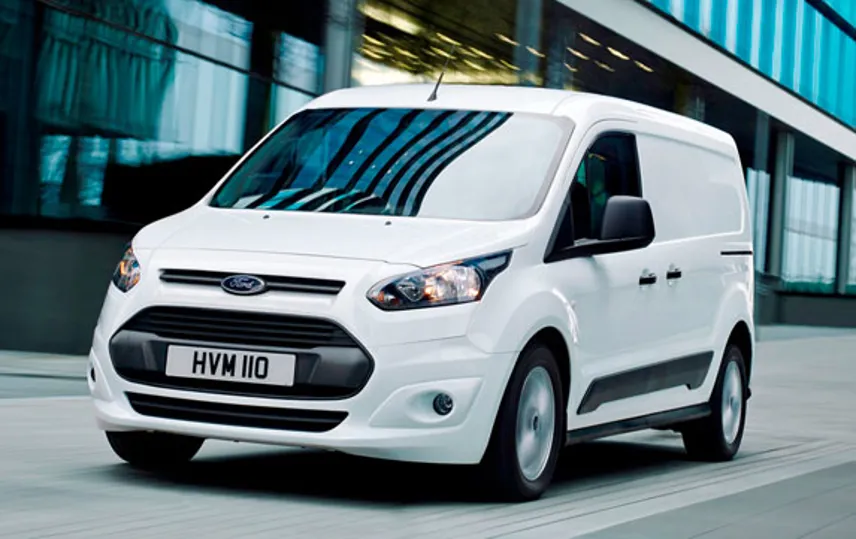Review
Ford is confident that the new Transit Connect van will leapfrog its rivals to become the third biggest selling van in the UK, beaten only by Ford’s two larger Transit variants.
Phil Hollins, director of fleet operations at Ford, wants to see “more than 20,000” registrations a year with most going to the corporate sector. That compares to around 8,000 for the outgoing Connect.
Are his bullish aspirations well-founded?
To succeed, the Connect needs to meet a number of core fleet criteria: fit for purpose, cost of ownership, loadspace, reliability and driver experience.
Loadspace: the Connect can accommodate two europallets, while the load-through bulkhead fits items up to three metres long in a short wheelbase van (L1 – 2,662mm) and up to 3.5m in a long wheelbase model (L2 – 3,067mm).
Note, though, that this is a £130+VAT option on the base model.
In addition, the bulkhead has been sculpted to create room for an 8x4 board if required. The load height of 1,270mm is the only option, and payload ranges from 600kg to a class-leading 1,000kg.
That’s a clear tick then. But do the cost of ownership figures stack up?
Ford has addressed this issue in a number of ways. First it has introduced the most fuel efficient engines in the sector.
The most popular fleet engine will be the 1.6-litre 95bhp Duratorq, which offers 115g/km and 64.2mpg with stop-start, while an Econetic version lowers this to 105g/km and 70.6mpg, although note that this is achieved by setting the speed limiter at 62mph.
Ford has tackled SMR costs by focusing on ways to extend the life of both scheduled and non-scheduled maintenance items and make any repairs easier and quicker to perform.
Larger tyres (16-inch instead of 15-inch) extend life by around 10%, while improving durability and protection.
Attention-to-detail design includes bending the exhaust inlet pipe to ease access to items such as starter motors, enabling speedy repairs and less off-road time.
Other innovations are intended to cut the cost of accident repair, for example raising headlamps to protect them in frontal crashes and splitting the bumper into three sections to limit the cost of replacement.
Data from MaintBook, the industry’s authority on SMR costs, suggests that, like-for-like, the Connect has a 13% lower fuel and SMR cost than the Volkswagen Caddy and 15% lower than the Citroën Berlingo/Peugeot Partner.
Residuals over four years/80,000 miles are 26% for the 1.6 95bhp Duratorq L1, up from 21% for the outgoing model. Caddy is around 25% in comparison.
A strong financial argument, then, although the jury is still out on just how much difference the improvements will make.
Ford has also strived to produce a vehicle that will meet with drivers’ approval. Transit Connect is a good-looking van, with several styling features lifted from Ford’s car range.
The range starts with a low cost Base derivative, expected to be most popular among corporate customers, rising through Trend to Limited. The ‘no-frills’ Base option includes electronic stability control as standard.
Ford’s Active CitySafe system, which brakes the van to standstill below 20mph if it detects an impending crash, is available as an option.
Hollins says a number of larger fleets are considering it; he believes lower insurance premiums can be negotiated as a result.
Behind the wheel
We tested the 1.6-litre 95bhp, 170lb-ft Duratorq engine with a block of wood equivalent to half the payload in the back. Capable of 64.2mpg, during our test it hovered just below 50mpg without too much effort.
Mid-range performance was decent, but pick up from low speeds in higher gears was ponderous.
The ride was excellent (the chassis is based on the C-Max/Kuga platform), with minimal body roll in corners although the pre-production passenger seats were overly firm. Ford says this has been addressed before deliveries started this month.
Tweaks to the cruise control functionality means that, whereas previously the ‘resume’ system would use maximum power and torque to get the van back up to speed after slowing down, now acceleration is steadier.
This improves fuel efficiency.
Driving dynamics impressed; employees could have few gripes about racking up the miles in this van.



















